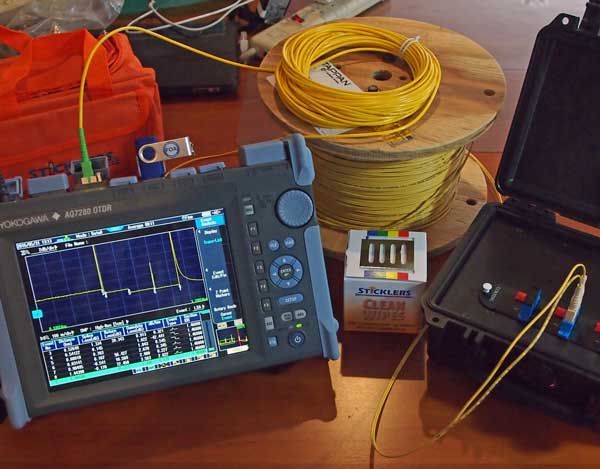Engineers utilize the optical fibre diameter analyser to verify fibre uniformity.
Engineers utilize the optical fibre diameter analyser to verify fibre uniformity.
Blog Article
The Role of Optical Fiber Testing in Ensuring High Quality and Efficiency in Connection Solutions
In today's quickly developing digital landscape, the importance of optical fibre screening can not be overemphasized, as it offers as a keystone for ensuring the quality and effectiveness of connection services. As modern technology proceeds to breakthrough, the future of optical fibre testing postures interesting difficulties and possibilities that warrant closer examination.
Relevance of Optical Fibre Screening
The importance of optical fibre screening can not be overstated in making sure the honesty and efficiency of interaction networks. As the foundation of modern-day telecommunications, optical fibres help with high-speed data transmission, making their dependability important to functional success. Examining offers as a proactive procedure to recognize potential concerns such as signal loss, attenuation, and physical damage, which can jeopardize network efficiency.
Routine testing permits the verification of setup top quality and the detection of issues that can affect data integrity - optical fibre testing equipment. By employing strenuous screening procedures, network operators can mitigate the threats related to network failings, including downtime and economic losses. Optical fiber testing makes sure compliance with industry standards and policies, improving the overall quality of service supplied to end-users.
Eventually, the methodical analysis of optical fibres adds to the long life and effectiveness of interaction systems. It makes it possible for stakeholders to make educated decisions concerning upkeep, upgrades, and troubleshooting. In a landscape where information is increasingly important, focusing on optical fibre screening is necessary to maintaining durable and efficient connectivity options, thereby sustaining the needs of contemporary electronic settings.
Types of Optical Fibre Tests
Numerous screening methods are utilized to guarantee the performance and integrity of optical fibers within communication networks. These tests can be generally categorized right into 2 primary kinds: installment examinations and maintenance examinations.
Setup tests are performed quickly after the setup of optical fibre cables to confirm their efficiency and honesty - fibre testing equipment. The most common setup examinations include Optical Time-Domain Reflectometry (OTDR) tests, which analyze the high quality of the fibre by identifying mistakes or breaks, and end-to-end loss examinations, which gauge the total optical loss from one end of the fiber to the other
Upkeep tests, on the various other hand, are executed periodically to ensure recurring efficiency and find prospective problems over time. These include visual assessment, which checks for physical problems or inappropriate installments, and continuity tests, which confirm that the signal can travel through the fibre without disruption.
In addition, advanced tests such as Polarization Mode Diffusion (PMD) and Chromatic Diffusion (CD) examinations can be conducted to assess the fiber's performance under different conditions. By utilizing these varied testing methods, specialists can keep high criteria of quality and dependability in optical fiber networks.
Benefits of Routine Checking
Routine screening of optical fibres plays a crucial duty in keeping the general efficiency and reliability of communication networks. By performing regular analyses, companies can make sure that their fibre optic setups fulfill industry standards and operate effectively. This positive strategy helps to identify possible weaknesses and degradation with time, permitting timely interventions before concerns escalate.
Cost-effectiveness is one more benefit. By Web Site addressing minor concerns early, companies can prevent the high prices connected with significant click fixings or system failures. Routine testing additionally promotes conformity with regulative requirements, ensuring that the network follows needed safety and security and performance criteria.
Common Concerns Identified
Determining usual concerns in optical fiber networks is important for preserving ideal efficiency and reliability. Various aspects can add to interruptions, including physical damage, poor installation practices, and environmental influences.
Physical damage, such as bends, breaks, or abrasions, can considerably degrade signal top quality. Inappropriate installation strategies, consisting of too much stress or insufficient securing of wires, may lead to boosted attenuation and loss of connectivity. In addition, ecological aspects such as temperature level fluctuations, moisture access, and rodent disturbance can endanger the stability of the fibre.
Connector problems also often develop, with improper alignment or contamination causing boosted insertion loss. Splicing errors can present considerable signal degradation if not carried out with accuracy.

Resolving these typical problems via routine optical fiber testing not just boosts network reliability yet additionally optimizes total performance, making certain that connection options continue to be robust and efficient.
Future Patterns in Testing
As the need for high-speed connectivity continues to rise, the future of optical fibre screening will progressively concentrate on automation and progressed analytics. The integration of expert system (AI) and maker knowing (ML) in screening processes will make it possible for much more reliable information analysis and predictive maintenance, decreasing downtime and improving total network reliability. Automated testing solutions will enhance the examination and qualification of fibre networks, minimizing human error and raising screening throughput.
An additional substantial pattern is the adoption of remote testing innovations. As the deployment of fiber networks expands into remote and underserved locations, remote testing capacities will permit professionals to keep an eye on and identify network conditions without physical visibility, thereby reducing functional expenses and improving feedback times.
Additionally, there will certainly be a change in the direction of even more comprehensive testing standards that incorporate not just typical loss dimensions but likewise performance metrics such as latency and data transfer utilization. This all natural approach will facilitate better network administration and optimization techniques.
As these patterns evolve, the optical fibre screening landscape will not just boost the high quality and performance of connectivity options but additionally sustain the growing intricacies of contemporary interaction networks.
Conclusion
In verdict, optical fiber screening serves as a fundamental component in keeping the integrity and efficiency of communication networks. The ongoing commitment to regular testing not just improves information transmission but likewise lines up with market requirements, fostering integrity in network frameworks.
Report this page